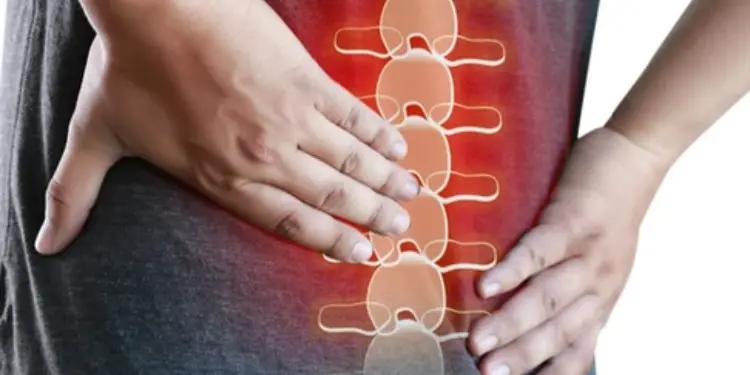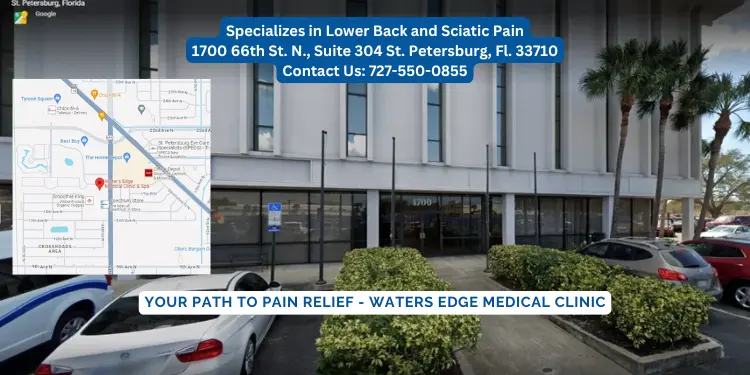Suffering from low back pain can be overwhelming, impacting every aspect of your daily life. However, finding Low Back Pain Treatment Near You doesn’t have to be a daunting task. In this comprehensive guide, we delve into the ultimate strategies to effectively alleviate low back pain and regain control of your comfort and mobility.
Whether you’re seeking chiropractic care, physical therapy, or alternative treatments, knowing your options is key to making informed decisions about your health. Explore effective treatments that tackle the source of your pain and simplify your options.

From holistic approaches to cutting-edge medical interventions, this guide helps you find the best low back pain treatment near you. Say goodbye to constant discomfort and hello to a life with renewed vitality and freedom of movement – it’s time to take charge of your well-being.
Understanding Low Back Pain
Millions worldwide suffer from the common issue of low back pain, often serving as a significant barrier to daily activities. It may present as a dull ache, sharp pain, or even stiffness that restricts movement. Importantly, this discomfort can arise suddenly or develop gradually over time. The variability in its presentation makes understanding low back pain essential for effective treatment and management.
The spine’s lumbar region consists of five sturdy vertebrae, and it’s not uncommon for issues in this area to lead to discomfort that radiates into the hips or legs. Factors such as age, lifestyle, and overall health can influence the severity and frequency of low back pain. For many, the pain can impede work, leisure activities, and even sleep, creating a vicious cycle of discomfort and frustration. Understanding the nature of your pain is the first step toward finding relief.
Additionally, low back pain can be classified into two categories: acute and chronic. Acute pain lasts under three months and often stems from injury or strain. Conversely, chronic pain persists for more than three months and may be associated with underlying health issues. Recognizing these distinctions can guide your approach to treatment and help you seek the appropriate care that aligns with your specific needs.
Common Causes of Low Back Pain
Determining the source of low back pain leads to better treatment outcomes. One of the most common culprits is muscle or ligament strain, often resulting from heavy lifting, sudden awkward movements, or repetitive activities that put stress on the back. Poor posture, especially during prolonged sitting, may lead to lower back pain.
Another significant factor is degenerative disc disease, which occurs when the intervertebral discs lose hydration and elasticity, leading to decreased cushioning between the vertebrae. This condition often exacerbates discomfort and stiffness, making everyday tasks challenging. Conditions like spinal stenosis, herniated discs, and osteoarthritis can contribute to low back pain, can further complicate the pain experience, requiring a multifaceted approach to treatment.
In some instances, low back pain can stem from more serious medical conditions, including infections, tumors, or fractures. While these cases are less common, they underscore the importance of seeking professional evaluation when experiencing persistent or severe pain. Understanding the root causes of your discomfort is vital for developing an effective treatment plan that targets the specific issues contributing to your low back pain.
Importance of Seeking Professional Help
When managing low back pain, seeking professional help is crucial for several reasons. Healthcare providers have the expertise to pinpoint the cause of your pain. This diagnosis is essential for formulating an appropriate treatment plan tailored to your unique situation. Relying solely on self-diagnosis or trial-and-error remedies can lead to wasted time, increased discomfort, and potential worsening of the condition.
Professionals use X-rays, MRIs, and CT scans for precise spinal diagnosis. These imaging techniques allow healthcare professionals to assess structural issues, identify herniated discs, or discover alignment problems that may not be apparent through physical examination alone. Understanding these underlying factors can vastly improve the effectiveness of your treatment regimen.
Finally, a healthcare provider can guide you through the various treatment options available, including non-invasive techniques, medications, regenerative medicine and lastly surgical interventions if necessary. Their expertise can also help you navigate lifestyle changes and modifications that may alleviate pain and prevent future episodes. Expert guidance helps you to manage pain and improve your health.
Non-Invasive Low Back Pain Treatment Options
Non-invasive treatment options for low back pain are often the first line of defense in managing discomfort. These approaches can provide significant relief while minimizing risks associated with more invasive procedures. One common method includes physical therapy, where trained professionals work with patients to develop customized exercise regimens aimed at strengthening the muscles that support the spine. This helps strengthen surrounding muscles and also helps prevent future injuries by improving flexibility and posture.
Another effective and non-invasive treatment is the use of regenerative medicine, including Platelet rich plasma, mesenchymal stem cell therapy and exosome therapy. These human cellular therapies help restore and regenerate normal function in the spine. This newest technology is gaining popularity. More and more trials and studies are occurring, and results are showing tremendous success.
Over-the-counter NSAIDs are the most common non-invasive treatment. NSAIDs reduce inflammation and ease pain, aiding daily activities. Consult a doctor and follow directions when taking these medications. These medications should only be used for a short time frame as they have daunting side effects. Also these medications do help decrease inflammation, but they do not fix the underlying problem.
Additionally, other alternative treatments may include chiropractic, acupuncture, massage therapy, and yoga have gained popularity for their potential benefits in managing low back pain. Chiropractic uses manual therapy or manipulation to improve alignment of the spine and surrounding muscles.
Acupuncture stimulates specific points to encourage pain relief and recovery. Massage relaxes muscles and boosts circulation, while yoga enhances flexibility and mindfulness. Exploring these non-invasive options can lead to significant improvements in overall well-being and pain relief.
Surgical Low Back Pain Treatment Options
Surgical options may be necessary if conservative treatments don’t work. Surgical interventions are typically reserved for severe conditions such as herniated discs, spinal stenosis, or chronic pain resulting from structural abnormalities. One common procedure is a discectomy, where the portion of a herniated disc pressing on a nerve is removed to alleviate pain and restore mobility.
Spinal fusion links two or more vertebrae to improve spine support and ease pain. Individuals with spondylolisthesis or degenerative disc disease may benefit from this procedure, where one vertebra slips out of place. Surgeons may also utilize minimally invasive techniques, which involve smaller incisions and minimally invasive techniques reduce tissue disruption, speeding up recovery.
While surgery can offer significant relief, a careful evaluation of risks and benefits is essential. Complications can arise, including infections, blood clots, or nerve damage. Therefore, A thorough discussion with a doctor ensures surgery is the right choice for you. Understanding outcomes allows individuals to choose the right treatment.
Choosing the Right Healthcare Provider for Low Back Pain
Selecting the appropriate healthcare provider is a critical step in effectively managing low back pain. Start by identifying professionals who specialize in musculoskeletal issues, such as orthopedic surgeons, physical therapists, or chiropractors. Every specialist offers unique expertise to guide your treatment choices.

When choosing a provider, consider their qualifications, experience, and patient reviews. Research their educational background, board certifications, and any specialized training in treating low back pain. Hearing from past patients can give insight into a provider’s treatment style, attentiveness, and effectiveness in addressing specific health concerns. Carefully considering your options can result in a more positive and effective treatment journey.
Additionally, maintain open lines of communication with your healthcare provider. Discuss your pain levels, lifestyle, and any concerns you may have about your treatment plan. A good provider will take the time to listen and collaborate with you on the best course of action. When you build trust with your provider, you create a foundation for more effective treatment and a smoother experience in managing low back pain.
Physical Therapy for Low Back Pain
Non-invasive low back pain management relies heavily on physical therapy to promote recovery and prevent future issues. Through a comprehensive evaluation, a physical therapist will examine your posture, flexibility, and strength to develop a personalized treatment plan. Based on these findings, they will design a personalized exercise program aimed at addressing your specific pain triggers and needs.
Therapeutic exercises often include stretching, strengthening, and aerobic conditioning to improve overall fitness levels. These activities can enhance muscle support around the spine, promote better posture, and increase mobility. Additionally, manual therapy methods such as joint mobilization and soft tissue manipulation may be applied to relieve pain and restore function.
Education is also a critical component of physical therapy. Your therapist will guide you on proper body mechanics and ergonomics, helping you learn how to move safely and effectively in your daily life. This knowledge can empower you to prevent future injuries and manage any recurring pain more effectively. Participating in physical therapy can provide lasting benefits, helping you restore mobility and improve overall comfort.
Chiropractic Care for Low Back Pain
Chiropractic care is another popular non-invasive treatment option for individuals suffering from low back pain. The primary focus of chiropractors is to diagnose and treat musculoskeletal disorders, especially those affecting the spine. They employ manual manipulation techniques, known as spinal adjustments, to align the vertebrae and improve overall spinal function. This realignment can alleviate pain, reduce nerve irritation, and enhance mobility.
Chiropractic treatment often goes beyond spinal adjustments, including complementary therapies like ultrasound, electrical stimulation, and targeted exercises. Each of these modalities aims to reduce pain and inflammation while promoting healing. Many patients benefit from combining chiropractic care and physical therapy, creating a well-rounded approach to low back pain management.
To receive the best care, it’s important to choose a chiropractor who is both licensed and experienced. During your initial consultation, discuss your specific pain concerns and treatment goals. A reputable chiropractor will tailor their approach to meet your individual needs, helping you achieve the best possible outcomes in your journey toward pain relief and improved quality of life.
Alternative Low Back Pain Treatment Methods
Considering alternative treatment options can be helpful for those looking to alleviate low back pain. One widely recognized option is acupuncture, an ancient practice rooted in traditional Chinese medicine. This method uses fine needles inserted at specific body points to enhance energy flow and support healing. This therapy works by inserting fine needles into key points on the body, encouraging energy flow and facilitating recovery.
Massage therapy is a beneficial alternative treatment that can help alleviate low back pain and promote relaxation. Trained massage therapists utilize various techniques to target muscle tension, improve circulation, and promote relaxation. Consistent massage therapy can reduce chronic pain and enhance mobility, making it a beneficial part of a well-rounded treatment plan.
Incorporating mindfulness techniques, such as yoga and meditation, can significantly aid in low back pain management. These practices promote relaxation, enhance flexibility, and encourage a deeper awareness of the body. By incorporating mindfulness techniques into your routine, you can develop effective coping strategies to manage pain and reduce stress, further contributing to your overall recovery process.
Regenerative medicine for treatment of Low Back Pain
Regenerative medicine is a great treatment for lower back pain. These treatments can include PRP therapy, stem cell therapy and exosome therapy.
- PRP (Platelet-Rich Plasma) Therapy:
- What it is: In PRP treatment, a small amount of blood is drawn, processed to enhance platelet concentration, and then reintroduced to the injured site to support tissue repair and reduce inflammation.
- How it helps: It can aid in healing damaged discs, ligaments, and muscles, reducing pain and improving function.
- Treatment options: Often done in a series of 1–3 injections, spaced weeks apart.
- Downtime: Minimal; most people return to normal activities within a few days but may need to avoid intense exercise for a couple of weeks.
- Cost: Depending on the provider and location, PRP injections generally range in price from $500 to $2,500.
- Stem Cell Therapy:
- What it is: Stem cells or mesenchymal stem cells derived from the Whartons jelly of the umbilical cord are injected into the lower back to repair and restore function to damaged discs, joints, and muscles.
- How it helps: Stem cells can reduce inflammation, regenerate damaged tissues, and help with chronic pain by promoting long-term healing.
- Treatment options: Usually a single injection, though some cases may require follow-ups.
- Downtime: Mild soreness for a few days, but most activities can be resumed quickly. Heavy lifting or intense workouts may need to be postponed for a few weeks.
- Cost: $5,000 to $10,000 per treatment, though prices can go higher depending on the type of stem cells used and the extent of the procedure.
- Exosome Therapy:
- What it is: Exosomes are small vesicles secreted by stem cells that carry proteins, growth factors, and genetic material to stimulate healing and reduce inflammation.
- How it helps: They work by signaling cells to repair and regenerate tissues, offering pain relief and improving mobility in the lower back.
- Treatment options: Typically one injection, though some protocols may suggest additional treatments depending on the severity of the condition.
- Downtime: Very minimal — similar to PRP, with most people resuming normal activities quickly.
- Cost: Around $3,000 to $7,000 per session.
Conclusion and Next Steps
Navigating the landscape of low back pain treatment options can seem overwhelming, but understanding your choices is key to regaining control over your health and well-being. Whether opting for non-invasive treatments like physical therapy and chiropractic care or considering surgical interventions, the important factor is finding the approach that aligns with your unique needs and circumstances.
As you explore various treatment options, prioritize seeking professional help from qualified healthcare providers. At Waters Edge Medical Clinic we specialize in lower back and spinal problems. We use state of the art therapies including regenerative medicine to help heal and regenerate affected tissues, tendons, ligaments and discs. We can offer valuable insights and guidance, ensuring that you make informed decisions along your journey. Remember to communicate openly about your pain levels, treatment preferences, and any concerns you may have, as this collaboration can significantly enhance your treatment experience.
Embarking on this journey towards pain relief requires patience and persistence. With the right strategies and support, you can reclaim your mobility and embrace a life free from the limitations of low back pain. Take the first step today by researching local healthcare providers, exploring treatment options, and empowering yourself to seek the relief you deserve.
To learn more or to see if we might be able to help you, please contact us at Waters Edge Medical Clinic and receive a free consultation and evaluation. You can contact us directly at 727-550-0855.


